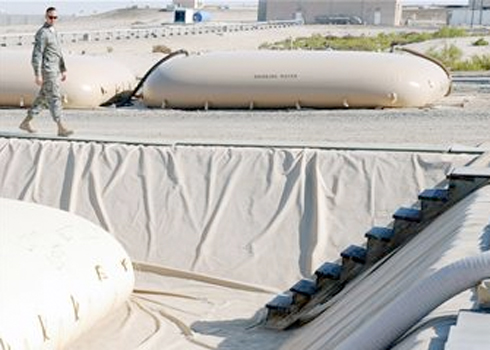The U.S. Army is getting rid of its “pen and paper” and “string and stick” method of tracking fuel use in Afghanistan after nearly a decade of mismanagement, theft and fraud resulting in what is likely hundreds of millions if not billions of dollars in lost fuel, some of which is sold on the black market and has ended up in Taliban hands.
The highest levels of the U.S. military have deep concerns about the rampant robbery, and the U.S. Army this week is beginning to implement, base by base in Afghanistan, a computerized accounting system aimed at making it easier to track the disappearing fuel.
“This has very senior leader attention,” Col. Phil Vonholtz, the commander of the Army Petroleum Center told TPM in a telephone interview. “I have personally briefed [Army Secretary John McHugh]. It has the attention at the highest levels…”
When asked why it has taken the military so long to implement basic safeguards in Afghanistan and Iraq, Vonholtz said he had only worked at the Center since July of 2009 and didn’t know what had caused the delays.
Last week, a TPM investigation reported that the Defense Department is under intense pressure to find a way to staunch the fuel losses in and out of its bases in Afghanistan and Iraq, especially considering the rising costs of oil in the wake of Middle East unrest and Congress’ intensified efforts to cut government waste, fraud and abuse anywhere they can find it.
When TPM first inquired about the steps and safeguards the U.S. military had taken over the years to guard against fuel theft, a Defense Logistics Agency spokeswoman said she knew of only one: a decision to provide payment for the fuel only upon delivery because there had been so many incidents of fuel disappearing from trucks before reaching bases in Afghanistan.
If fuel is stolen from the truck, the U.S. military won’t pay for it — the contractor has the responsibility for securing, transporting and safeguarding it, the spokeswoman said.
That decision was aimed at the wide-scale theft that occurs as the Afghan fuel trucks traversed dangerous terrain and various tribal boundaries on it ways to U.S. military bases, but it did nothing to guard against the heists and corruption occurring once fuel is delivered to the U.S. installations, and any subsequent theft while the fuel is making its way to outlying bases.
The Army’s new accounting software system, dubbed Tactical Fuels Manager Defense, is aimed at plugging the gaping holes in what is now largely a pen-and-paper process.
The Army Petroleum Center’s staff are in Afghanistan this week to get the accounting system up and running in the first of 36 select U.S. bases in the country. The TFMD software will issue discrepancy reports when deliveries, inventory and dispatches don’t match up.
The pen and paper system was rife with corruption, and several soldiers over the past few years were caught accepting bribes in return for submitting fraudulent paperwork permitting trucking contractors to steal millions of dollars in fuel from the military. The most recent, Army Sergeant Stevan Nathan Ringo, was sentenced in early January to nearly seven years for taking more than $400,000 in bribes over the course of a few months.
The new accounting software would allow the military to send daily fuel statistics from 36 of the busiest bases in Afghanistan to a centralized headquarters in the U.S. for evaluation. Varec, a subsidiary of defense giant SAIC, was selected last year to come up with the software after the Army received a $4 million earmark in a 2009 supplemental spending bill labeled simply “fuel accountability,” according to VonHoltz.
Unlike most earmarks, this one did not list a requesting member of Congress’ name or committee attached to it, VonHoltz said, so there’s no way to know which House member of senator requested it.
The Army also plans to develop an automatic gauge to measure the amount of fuel at any given time held in 10,000- to 210,000-gallon collapsible fabric bladders located on bases in Afghanistan.
Right now the military can only assess the levels by measuring the height and width of the fuel bags, and then using “a string and two sticks” dropped into the bladders to come up with a rough estimate of the fuel contents, VonHoltz said.
“When you’ve got people measuring with a couple of sticks and strings, there’s room for error,” he said.
In late November, the Army Petroleum Center publicly asked defense contractors to come up with proposals for a digital gauge that could measure volume in the bladders and download those numbers real-time to a central location using wired technology.
The announcement, however, is what is known as a request for information, the DoD’s first step in researching the matter, and does not involve an actual contract to make and supply the gauges. Developing and suppling the gauges could be months or even years in the making.
In 20 of the 36 bases selected for more fuel safeguards, the Army also has purchased hand-held automated data capture devices, which can record fuel levels from vehicles and download that information to the TFMD accounting system. The devices can read soldiers and contractors’ ID cards, preventing unauthorized vehicles from filling up at fuel stations.
Vonholtz acknowledges the accounting software is not fool-proof, but hopes it will curb the large-scale fuel theft that has taken place over the last decade.
“We believe the system that we’re deploying is not going to stop [the theft] completely, but it will allow us to address it and deal with it much quicker,” VonHoltz said.









